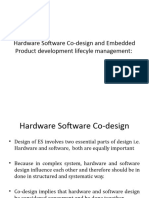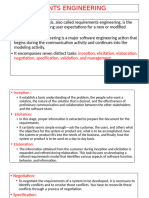What Is Software?: Applications Are of Two Types
What Is Software?: Applications Are of Two Types
Uploaded by
sachinCopyright:
Available Formats
What Is Software?: Applications Are of Two Types
What Is Software?: Applications Are of Two Types
Uploaded by
sachinOriginal Description:
Original Title
Copyright
Available Formats
Share this document
Did you find this document useful?
Is this content inappropriate?
Copyright:
Available Formats
What Is Software?: Applications Are of Two Types
What Is Software?: Applications Are of Two Types
Uploaded by
sachinCopyright:
Available Formats
What is Software?
◦ Software is nothing but collection of programs’
◦ Program that tells a computer how to perform tasks
◦ Software application is a set of programs designed to perform a specific task for the user
What is Testing?
◦ Testing is a process of checking whether the given software or application is behaving as expected
◦ There is different type of testing with different purpose like white box, black box etc.
◦ Testing is a group of techniques to determine the correctness of the application under the predefined
script but, testing cannot find all the defect of application. The main intent of testing is to detect failures
of the application so that failures can be discovered and corrected. It does not demonstrate that a
product functions properly under all conditions but only that it is not working in some specific
conditions.
Different type of Application & its categories
◦ Applications are of two types
◦ Product - Any application is called as product when it offers standard set of functionalities for
different customers, for example ATM machine
◦ Project- Any application which is developed a single customer based on his/her specific needs,
for example bank portal
◦ Project is categories in two types
◦ Critical project – Where there is financial transactions are there like banking
applications.
◦ Normal project
Ekta Barlota 8983159233 ekta224286@gmail.com
Resources available in software development
•It provides high level idea , how he/she want the application
Customer
Business
• BA discuss with the Customer and gather the information
Analyst
•Developed application as per requirement
Developer
•Check correctness and completeness of application
Tester
What is SDLC?
◦ SDLC means software development life cycle
◦ It is a process which includes various phases that are followed to develop the software application
◦ SDLC is having different stages/phases and each phase has its various activities
◦ Different approach/methodology like agile, waterfall will be used but everyone has these stages
Different phases of software development life cycle
Ekta Barlota 8983159233 ekta224286@gmail.com
Information Gathering/Requirement Gathering
• Business Analyst is responsible for information gathering
• Information gathering is nothing but requirement gathering from customer
• Information gathering involve business requirement specification/document
• Business Analyst prepare business requirement specification/document (BRS)
• The requirement includes how the product will be used and who will use the product to determine the
load of operations. All information gathered from this phase is critical to developing the product as per
the customer requirements.
BRS Template for reference
Ekta Barlota 8983159233 ekta224286@gmail.com
Analysis
• Business Analyst involve in this process
• Outcome of this process is SRS (System Requirement Specification)
• SRS document is made after BRS
• SRS is bible of the project and is detailed documentation
• Following document will be part of SRS
I. Functional flow diagram
II. Functional requirement
III. User Case
IV. Snapshots
Difference between the BRS and SRS
BRS SRS
This is high level requirement gathering This is detailed specification
Example – Facebook Example- Same Application
• Sign up Page • Sign Up Page –
• User should be able to sign • It should have first name,
up last name, email, mobile
number and password
field
• Mobile Number and email
should get OTP/link for
verification
• Standard validation should
be applicable
Ekta Barlota 8983159233 ekta224286@gmail.com
Functional flow diagram
• It helps to understand process flow of it
• It represents relationship between the tasks and it gives proper sequence of task
• Flow diagram is commonly used by the product manager, designer, or people who need to talk about
how the business works
• Please refer the below functional flow diagram for facebook
Ekta Barlota 8983159233 ekta224286@gmail.com
Functional Requirement
• Each and functionality is drilled down in details
• It contains what are the fields will be present, what will be validation etc.
Assignment – Write down the functional requirement for the rest of the fields
Use Case
• It represents list of different roles/actors
• It represents list of actions/task a specific user/actor can perform
• It is nothing but the description of the ways in which user interacts with a system
• Below is the example of Facebook where we have two actor and different action each actor can perform
Ekta Barlota 8983159233 ekta224286@gmail.com
Snapshot
• It will be developed by BA/designer
• It will give the idea to the developer that how system supposed to look like
• There are multiple software/application in market for this like invision
• Below is the snapshot of the Facebook home page with sign up page
Design
• It is the most crucial phase in the development of a system.
• The logical design produced during the analysis is turned into a physical design - a detailed description
of what is needed to solve original problem.
• In this phase, the requirement gathered in the SRS document is used as an input
• In the stage, the programming language and the hardware and software platform in which the new
system will run are also decided.
• There are two type of design –
• High Level - It is the overall system design - covering the system architecture and database
design.
• Low Level design- It is based on high level design. It is more detail design which include sub-
module
Ekta Barlota 8983159233 ekta224286@gmail.com
Coding
• Coding means programming
• Set of programs written by developer will create software
• There are two types of developer – Front end developer and Backend Developer
• Front end developer will focus on programming the front end of website or app that a user will interact
with (the client side). Back-end developer focuses on the side of a website users can’t see (the server
side)
Testing
• Testing is the process of checking completeness/correctness of the software
• Testing is divided in three types
• White box testing
• Black box testing
• Gray box testing
Ekta Barlota 8983159233 ekta224286@gmail.com
White box testing
• It is performed by developer
• It is also called as unit testing/code level testing etc.
• It tests internal coding
• Developer will test every line of the code of the program. The developers perform the White
box testing and then send the application or the software to the testing team,
Black box testing
• It is performed by tester
• It is also known as Behavioral Testing
• A tester, without knowledge of the internal structures of a website, tests the web pages by using
a browser, providing inputs (clicks, keystrokes) and verifying the outputs against the expected
outcome.
• It further divided in functional /non-functional testing
Gray box testing
• It is performed by tester
• It is combination of White box and black box testing
• In Grey box testing, internal structure is partially known
• Generally, in product-based companies' tester performed grey box testing
Ekta Barlota 8983159233 ekta224286@gmail.com
Maintenance
◦ Maintenance means providing the services after the delivery of the project
◦ Maintenance involved technical and non-technical support
◦ Technical support is called KPO (Knowledge process outsourcing), it generally involve accounting, market
and legal research etc.
◦ Non-Technical support in call BPO (Business process outsourcing), it is generally call center for customer
assistance
SDLC Model
◦ There are various software development life cycle models defined and designed which are followed
during the software development process. These models are also referred as Software Development
Process Models
◦ Every model will follow all the SDLC stages
◦ Following are the most important and popular SDLC models
◦ Waterfall model
◦ Iterative model
◦ V-model
◦ Agile
Waterfall Model
• Winston Royce introduced the Waterfall Model in 1970
• It will have same stages as SDLC
• Developer must complete every phase before the next phase begins
Ekta Barlota 8983159233 ekta224286@gmail.com
When should we go for Waterfall?
• The requirements are well documented
• Product definition is stable
• The technologies are predefined which makes it not dynamic
• No ambiguous requirements
• The project is short
Advantages and Disadvantages of waterfall model
Advantages
◦ Simple and Easy to understand
◦ Management simplicity thanks to its rigidity: every phase has a defined result
◦ Perfect for the small or mid-sized projects where requirements are clear
Disadvantages
◦ The software is ready only after the last stage is over
◦ High risks and uncertainty
◦ Not the best choice for complex
◦ Once the application is in testing stage, it is difficult to go back and change what is uncertainty
◦ Not suitable for the projects where requirement is at a moderate to high risk of changing
Ekta Barlota 8983159233 ekta224286@gmail.com
You might also like
- Robin Frederick - Song Starters 365 Lyric, Melody, Chord Ideas To Kickstart Your SongwritingDocument187 pagesRobin Frederick - Song Starters 365 Lyric, Melody, Chord Ideas To Kickstart Your SongwritingAntonello Burtone100% (4)
- Software Engineering EconomicsDocument48 pagesSoftware Engineering Economicsmohmad mujhedNo ratings yet
- Respiratory Failure NCPDocument1 pageRespiratory Failure NCPkyaw100% (1)
- DEP Fixed Steel Offshore StructuresDocument36 pagesDEP Fixed Steel Offshore Structurespektoph100% (2)
- Introduction To Software EngineeringDocument48 pagesIntroduction To Software Engineeringmegharajendran184No ratings yet
- SE Complete Unit 2Document49 pagesSE Complete Unit 2Pavan KumarNo ratings yet
- Exp 3-Traditional Process ModelDocument14 pagesExp 3-Traditional Process Modelishmasiddique926No ratings yet
- Chapter 1Document35 pagesChapter 1Sushant YadavNo ratings yet
- SE Unit1Document110 pagesSE Unit1Prathamesh KulkarniNo ratings yet
- SE Unit-1Document111 pagesSE Unit-1anushakti.nadar143No ratings yet
- Online Job Portal-SRSDocument16 pagesOnline Job Portal-SRSnaganathan310150% (4)
- Classical Waterfall Model:: Mid Questions and Answers - 4sets PDF By: Venu GopalDocument22 pagesClassical Waterfall Model:: Mid Questions and Answers - 4sets PDF By: Venu Gopalspider dogNo ratings yet
- SDLC (Software Development Life Cycle)Document19 pagesSDLC (Software Development Life Cycle)Rushikesh RohamareNo ratings yet
- Chapter 17Document49 pagesChapter 17Atharv AmbokarNo ratings yet
- Requirement AnalysisDocument30 pagesRequirement Analysiszipzapstorm22No ratings yet
- Unit 3Document89 pagesUnit 3doneman536No ratings yet
- Software Engineering Unit 1Document63 pagesSoftware Engineering Unit 1Nida KhanNo ratings yet
- SDLCDocument42 pagesSDLCRama RajeshNo ratings yet
- Software Development Life CycleDocument13 pagesSoftware Development Life CycleLoc NguyenBaoNo ratings yet
- OOSE Unit 1 NotesDocument21 pagesOOSE Unit 1 Notesrakshithaashok247No ratings yet
- Unit IDocument74 pagesUnit ISk ShravanNo ratings yet
- Presentation On: Software Development Life CycleDocument27 pagesPresentation On: Software Development Life CycleLakhvir SinghNo ratings yet
- Slide 3 Requirements EngineeringDocument19 pagesSlide 3 Requirements EngineeringNathanel RupondoNo ratings yet
- Introduction To Requirement EngineeringDocument2 pagesIntroduction To Requirement EngineeringSUREDDY TANUJA MSCS2018No ratings yet
- Session 19Document21 pagesSession 19rajesh shekarNo ratings yet
- Session-6, Req. Engg.Document21 pagesSession-6, Req. Engg.rashi1704baranwalNo ratings yet
- Software Engineering IntroDocument26 pagesSoftware Engineering IntroForheen AhmedNo ratings yet
- System Development Life CycleDocument31 pagesSystem Development Life CycleHaziq ZahiruddinNo ratings yet
- Software Requirements EngineeringDocument45 pagesSoftware Requirements Engineeringwikiy72731No ratings yet
- Software Engineering: Unit-2Document41 pagesSoftware Engineering: Unit-2Rameswar ReddyNo ratings yet
- Requirement Engineering - Part 1Document28 pagesRequirement Engineering - Part 1api-237335979No ratings yet
- Softwere Development ProcessDocument21 pagesSoftwere Development ProcessEeiouNo ratings yet
- CLASS ManualtestingDocument119 pagesCLASS Manualtestingsivachandran kaliappanNo ratings yet
- 4288-1680525340710-SDLC Lecture 2Document34 pages4288-1680525340710-SDLC Lecture 2pasindusithangaxsNo ratings yet
- SE - Module 2Document41 pagesSE - Module 2rayobose51No ratings yet
- Chapter Four PMDocument35 pagesChapter Four PMSteve TekluNo ratings yet
- SDLCDocument6 pagesSDLCapi-3748142No ratings yet
- Unit 1seDocument40 pagesUnit 1semr. potterNo ratings yet
- Unit-2 Requirement Analysis & SpecificationDocument8 pagesUnit-2 Requirement Analysis & SpecificationJanki PatelNo ratings yet
- Software Engineering & Project Management: Code: C033514Document60 pagesSoftware Engineering & Project Management: Code: C033514Adity chandrakarNo ratings yet
- Software Life CyclesDocument12 pagesSoftware Life Cyclesbajelisanjay03No ratings yet
- Module 1Document72 pagesModule 1Rebecca AdrianNo ratings yet
- Software Models OverviewDocument45 pagesSoftware Models Overviewvenkata18ramyaNo ratings yet
- Unit I Software Product and ProcessDocument11 pagesUnit I Software Product and Processbhuvi2312No ratings yet
- Software Testing: Contact Session - 1Document40 pagesSoftware Testing: Contact Session - 1SohitNo ratings yet
- Unit IIDocument10 pagesUnit IIAlifa AzzuNo ratings yet
- Waterfall ModelDocument19 pagesWaterfall Modelfindshubham73No ratings yet
- Software Engineering Unit I Software Product and Process: Elements, Allocate Requirements To SoftwareDocument167 pagesSoftware Engineering Unit I Software Product and Process: Elements, Allocate Requirements To SoftwareChithambaram NanbanNo ratings yet
- W4 RequirementsAnalysisDocument31 pagesW4 RequirementsAnalysisjswaru12No ratings yet
- Syllabus: Module 1:-Phases of Software DevelopmentDocument34 pagesSyllabus: Module 1:-Phases of Software DevelopmentVaishnav ViswanathNo ratings yet
- Software Engineering U1-1Document119 pagesSoftware Engineering U1-1sahiljungare37No ratings yet
- Software Engineering: (SDLC & Software Process Model)Document44 pagesSoftware Engineering: (SDLC & Software Process Model)sayma meemNo ratings yet
- Presentation For C AssignmentDocument10 pagesPresentation For C Assignmentroshan ranaNo ratings yet
- SDLCDocument10 pagesSDLCng850808No ratings yet
- Requirement Analysis and SpecificationDocument51 pagesRequirement Analysis and SpecificationzatharoxNo ratings yet
- Sds FDocument52 pagesSds FShraddha BhandariNo ratings yet
- 1.what Is Software Development Life Cycle (SDLC) ?Document9 pages1.what Is Software Development Life Cycle (SDLC) ?masudNo ratings yet
- Software Engineering Unit 2Document55 pagesSoftware Engineering Unit 2tiwariadarsh1818No ratings yet
- Unit-2 - SDLC ModelsDocument48 pagesUnit-2 - SDLC ModelsOye it's hubNo ratings yet
- Incremental Prototyping ModelDocument11 pagesIncremental Prototyping ModelMuhammad JamshaidNo ratings yet
- SE - Module 2 - REDocument72 pagesSE - Module 2 - REVignesh TbFNo ratings yet
- Software Testing Interview Questions You'll Most Likely Be AskedFrom EverandSoftware Testing Interview Questions You'll Most Likely Be AskedNo ratings yet
- Gregorian-Lunar Calendar Conversion Table of 1979 (Ji-Wei - Year of The Goat)Document1 pageGregorian-Lunar Calendar Conversion Table of 1979 (Ji-Wei - Year of The Goat)Anomali SahamNo ratings yet
- Admit CardDocument3 pagesAdmit CardSONU SNo ratings yet
- Delhi Voter Inquiry DetailsDocument3 pagesDelhi Voter Inquiry DetailsKunal1328No ratings yet
- Boot Windows VHD From USB in UEFI and Legacy BIOS ModeDocument6 pagesBoot Windows VHD From USB in UEFI and Legacy BIOS Modetahmed999No ratings yet
- All chapter download Physical Science 9th Edition Tillery Test BankDocument35 pagesAll chapter download Physical Science 9th Edition Tillery Test BanklibensimueetNo ratings yet
- Periodic Table of ElementsDocument1 pagePeriodic Table of ElementsNicola ViradorNo ratings yet
- CEH09 - New Dumps 012017Document28 pagesCEH09 - New Dumps 012017Faizan QureshiNo ratings yet
- Comparatives 1Document2 pagesComparatives 1NiceShot85No ratings yet
- Foundation U1-L1Document29 pagesFoundation U1-L1nhapotect339No ratings yet
- UGC Net SyllabusDocument3 pagesUGC Net SyllabusKaranbirNo ratings yet
- Self Concept NursingDocument7 pagesSelf Concept NursingteabagmanNo ratings yet
- s4105588 PHD Final PDFDocument268 pagess4105588 PHD Final PDFCapo Dei KapiNo ratings yet
- Module 3 - Assessing and Diagnosing AbnormalityDocument33 pagesModule 3 - Assessing and Diagnosing Abnormalityxyryl ann mae capiliNo ratings yet
- Astm D 4810 - 2006Document3 pagesAstm D 4810 - 2006Nag RajNo ratings yet
- Reading Comprehension Non Fiction Grade 3 EinsteinDocument2 pagesReading Comprehension Non Fiction Grade 3 EinsteinMd. Zeeshan RahmanNo ratings yet
- Case Study 1 AssigmentDocument15 pagesCase Study 1 Assigmentabrham zebergaNo ratings yet
- Unit 1: Persisting and Securing Messages: Week 2: Expand Your SkillsDocument100 pagesUnit 1: Persisting and Securing Messages: Week 2: Expand Your Skillsmeenakshi2419No ratings yet
- Remotesensing 11 02105 v2Document22 pagesRemotesensing 11 02105 v2William Krista MahendraNo ratings yet
- Module 7 - StramaDocument8 pagesModule 7 - StramaJN CNo ratings yet
- NCP Chronic Pain and FatigueDocument6 pagesNCP Chronic Pain and FatigueMary Rose Bell Arias100% (1)
- How To Draw Piping IsometricsDocument18 pagesHow To Draw Piping IsometricsEmavwodia Solomon100% (1)
- Jena Mine Statement17 August 2022Document3 pagesJena Mine Statement17 August 2022Trust ZhouNo ratings yet
- Catechism SyllabusDocument4 pagesCatechism SyllabusIvy Myrel OliveraNo ratings yet
- Powermill 1Document2 pagesPowermill 1workman1No ratings yet
- GEA16092 Aluminum CaseStudyDocument2 pagesGEA16092 Aluminum CaseStudyPankajSinghBhatiNo ratings yet
- Consumer Credit and Over-Indebtedness in China: Huifen YinDocument19 pagesConsumer Credit and Over-Indebtedness in China: Huifen YinFadel MuhammadNo ratings yet
- November 2023 Online - Loyalty Management MagazineDocument25 pagesNovember 2023 Online - Loyalty Management MagazineLoyalty360No ratings yet

























































































